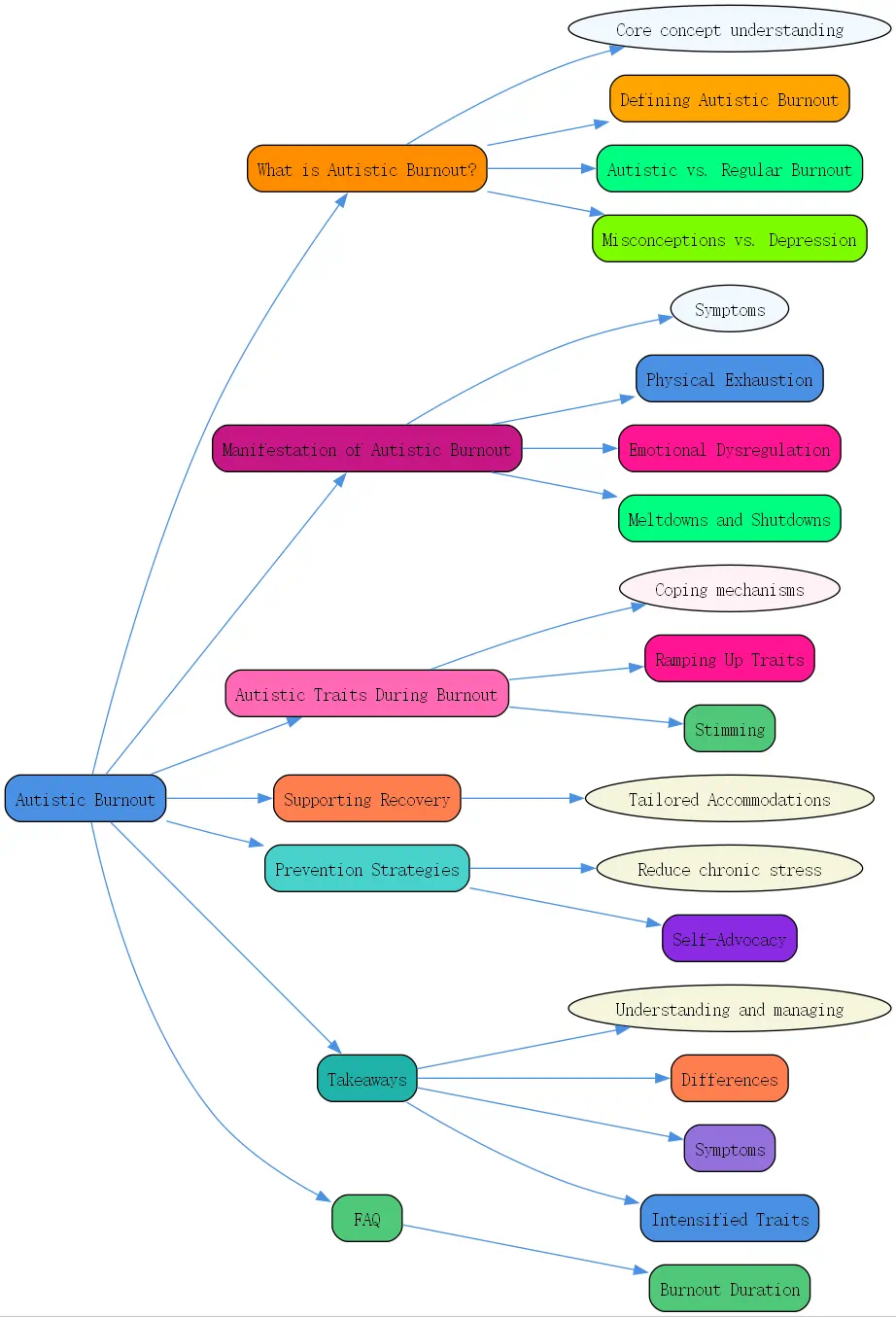What is Autistic Burnout? Understanding the Core Concept

Defining Autistic Burnout: A Personal Perspective
Autistic burnout represents a state of chronic exhaustion, increased sensory sensitivities, and reduced functioning that affects many individuals on the autism spectrum. At BrainTalking, we emphasize that autistic experiences are inherently individual – what one person experiences may differ significantly from another’s reality.
When discussing autistic burnout, it’s crucial to acknowledge this diversity of experience. Each autistic person has unique traits, challenges, and strengths that manifest in completely individual ways. No two autistic people are identical in how they experience the world, which extends to how autistic burnout feels and presents for each person.
Autistic Burnout vs. Burnout: Key Differences
While traditional burnout and autistic burnout share some similarities, they differ significantly in their underlying causes and manifestations. Regular burnout typically results from work-related stress, poor work-life balance, or extended periods of high pressure. In contrast, autistic burnout vs burnout shows distinct differences rooted in neurological differences.
Autistic burnout stems from the cumulative effects of constantly navigating a world not designed for autistic minds. The continuous effort to mask autistic traits, manage sensory sensitivities, navigate social situations, and process overwhelming information leads to a different kind of exhaustion. Unlike general burnout, which might improve with a vacation or job change, autistic burnout requires specific accommodations addressing sensory and social demands.
Common Misconceptions: Autistic Burnout vs. Depression/Sadness
One common misunderstanding about autistic burnout is confusing it with depression or general sadness. While there’s symptom overlap—exhaustion, withdrawal, and decreased functioning appear in both conditions—the root causes differ significantly. What’s autistic burnout, specifically? It’s a response to chronic overstimulation and the excessive energy expended to appear neurotypical, rather than a primary mood disorder.

An autistic person experiencing burnout might describe feelings that sound like depression, including deep fatigue and withdrawal from activities. However, these symptoms stem from different sources. Understanding this distinction is crucial for appropriate support and intervention. Some individuals may benefit from specialized support at depression recovery centers alongside autism-specific accommodations when both conditions co-occur.
How Autistic Burnout Manifests: Physical, Emotional, and Mental Symptoms
Physical Exhaustion: The Overwhelming Fatigue of Autistic Burnout
The physical component of autistic burnout often manifests as profound exhaustion that doesn’t improve with regular rest. This isn’t ordinary tiredness but a bone-deep weariness that affects every aspect of functioning. Many autistic individuals describe feeling like their energy reserves have completely depleted, leaving them unable to perform even basic self-care activities.
During periods of burnout autistic individuals may find themselves unable to engage in activities they typically enjoy. The exhaustion becomes so overwhelming that the person might prefer doing nothing rather than participating in previously pleasurable activities. This withdrawal resembles depression but stems from the body’s need to conserve energy after extended periods of overstimulation and masking.
Emotional Dysregulation: Heightened Sensitivity and Reactions
Emotional dysregulation represents another significant aspect of autistic burnout. Many experience increased difficulty managing their emotions during burnout periods. The carefully developed strategies for emotional regulation may suddenly become ineffective, leading to unexpected emotional responses.
Individuals experiencing autistic burnout often report feeling unable to control, manage, or understand their emotions. The filter that typically helps process and respond to emotional stimuli seems to disappear, resulting in emotions that feel raw and immediate. This might manifest as sudden anger, sadness, or agitation that appears without warning and feels unmanageable.
Meltdowns and Shutdowns: Understanding Autistic Reactions
Increased frequency of meltdowns and shutdowns often signals the onset or presence of autistic burnout. These responses differ fundamentally from tantrums, though they’re frequently misunderstood as such. A meltdown represents an involuntary response to overwhelming sensory input or emotional distress, while a shutdown involves withdrawing inward when overwhelm becomes too intense.
Unlike tantrums, which involve conscious behavior aimed at achieving a specific outcome, meltdowns and shutdowns are neurological responses beyond the individual’s control. During a meltdown, an autistic person cannot simply “”calm down”” on command; the nervous system is in an overloaded state that must run its course. Similarly, shutdowns involve the brain essentially “”rebooting”” to protect itself from further overstimulation.
During periods of burnout autistic people often experience more frequent meltdowns and shutdowns because their usual coping mechanisms and regulatory abilities have been compromised by exhaustion. This creates a challenging cycle where burnout leads to more meltdowns, which further depletes energy reserves.
Increased Anxiety: The Role of Comorbid Anxiety Disorders
Many autistic individuals also experience anxiety disorders, and these conditions often intensify during burnout periods. The comorbidity between autism and anxiety disorders like social anxiety disorder or generalized anxiety disorder is well-documented, making anxiety management particularly important during burnout.
During autistic burnout, anxiety levels may increase dramatically, becoming resistant to the person’s usual management strategies. The constant feeling of danger or worry becomes overwhelming and difficult to rationalize away. This heightened anxiety further contributes to exhaustion, creating another difficult cycle to break.
Increased Autistic Traits and Coping Mechanisms During Burnout

Ramping Up of Autistic Traits: A Sign of Burnout?
One notable feature of autistic burnout is the intensification of autistic traits that might otherwise be less pronounced or more effectively managed. This “”ramping up”” often serves as an important indicator that burnout may be occurring. Sensory sensitivities may become more acute, special interests might become more intense, and communication difficulties may increase.
For many autistic individuals, observing these changes in themselves provides valuable early warning signs of approaching burnout. Recognizing these patterns allows for proactive implementation of accommodations and support. Family members and caregivers can also learn to identify these shifts as potential signals that additional support may be needed.
Stimming: Self-Regulation and Sensory Processing
Stimming (self-stimulatory behavior) often increases significantly during periods of autistic burnout. These repetitive movements or sounds serve important functions for autistic individuals, including self-regulation, sensory processing, concentration enhancement, and emotional expression.
Common stimming behaviors include hand-flapping, rocking, tapping, spinning objects, or repetitive vocalizations. During burnout, these behaviors typically increase in frequency and intensity as the autistic person’s regulatory systems become overwhelmed. Rather than being discouraged, stimming should be recognized as an important coping mechanism that helps the individual process information and manage sensory input.
Burnout Autistic: Hair Pulling as a Stimming Example
One specific example of stimming that may increase during burnout is hair manipulation. This might involve twirling, pulling, or running fingers through hair repeatedly. For some individuals, this particular form of stimming helps with concentration and sensory regulation during overwhelming periods.
The sensory feedback from hair pulling or manipulation can provide regulatory input that helps an autistic person process information more effectively. While this behavior might appear unusual or concerning to outside observers, it serves an important function for the individual engaging in it. Understanding stimming behaviors as adaptive rather than problematic represents an important step in supporting autistic individuals through burnout periods.
Supporting Recovery from Autistic Burnout
Recovery from autistic burnout requires specific accommodations tailored to the individual’s needs. Unlike traditional burnout, where general rest might suffice, autistic burnout necessitates addressing the underlying factors causing neurological overload. This might include reducing sensory stimulation, decreasing social demands, providing more structure, and eliminating expectations of masking or camouflaging autistic traits.
Creating a supportive environment is crucial for recovery. This includes making sensory accommodations, establishing clear routines, and providing explicit communication. Family members, employers, and healthcare providers at depression recovery centers can all play important roles in supporting recovery by understanding the unique needs of autistic individuals during burnout periods.
For those supporting autistic loved ones through burnout, patience and understanding are essential. Recovery takes time and cannot be rushed. The goal should be creating sustainable environments that reduce the likelihood of future burnout rather than simply returning to previous functioning levels that may have contributed to the burnout in the first place.
Prevention Strategies for Autistic Burnout

Preventing autistic burnout involves implementing proactive strategies that reduce chronic stress and overload. Regular sensory breaks, reduced masking expectations, and appropriate accommodations in work and educational settings can significantly decrease burnout risk. BrainTalking specialists recommend developing personalized burnout prevention plans that address individual triggers and needs.
Self-advocacy skills also play a crucial role in burnout prevention. Learning to identify and communicate needs before reaching crisis points helps maintain overall well-being. For autistic individuals, developing a deep understanding of personal limits and boundaries represents an important protective factor against burnout.
Employers and educational institutions can contribute to burnout prevention by implementing autism-friendly policies and accommodations. These might include flexible work arrangements, sensory-friendly environments, clear communication protocols, and reduced social expectations. By creating more accessible environments, these institutions can help prevent the conditions that lead to autistic burnout.
Takeaways: Understanding and Managing Autistic Burnout
- Autistic burnout differs fundamentally from regular burnout, requiring specific understanding and interventions
- Physical exhaustion, emotional dysregulation, increased meltdowns/shutdowns, and heightened anxiety are common symptoms
- Intensified autistic traits and increased stimming often signal the presence of burnout
- Recovery requires specific accommodations addressing sensory, social, and masking demands
- Prevention strategies should focus on sustainable environments that respect autistic neurology
- Support from informed healthcare providers, including specialized depression recovery centers, may benefit those experiencing both depression and autistic burnout



